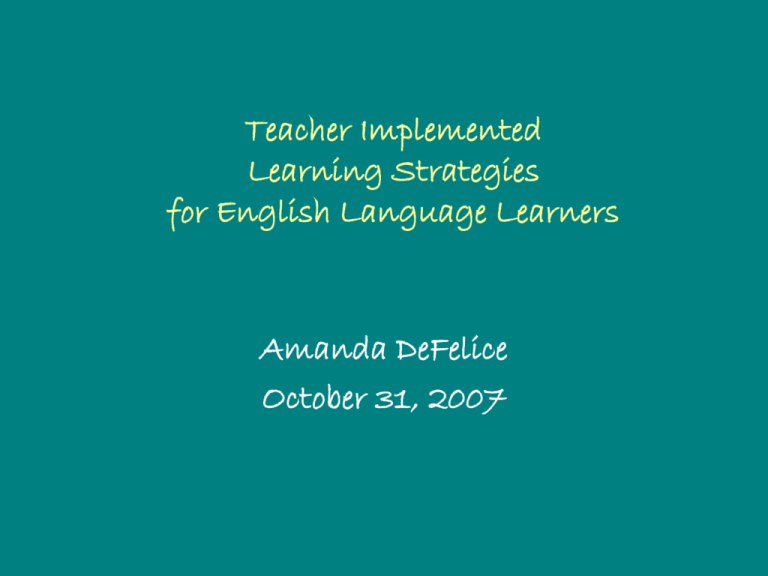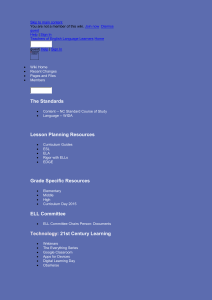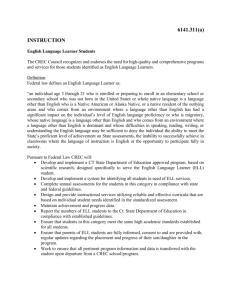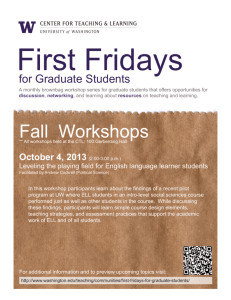Teacher Implemented Learning Strategies for English Language
advertisement

Teacher Implemented Learning Strategies for English Language Learners Amanda DeFelice October 31, 2007 Introduction • It is estimated that by the year 2015, the average classroom will have a fifty percent or more population of students from culturally diverse backgrounds. With this in mind, it’s obvious that the population of English Language Learners will increase as well. It is essential for teachers to learn and implement a variety of strategies because even though ELL’s may not speak English fluently, they still deserve an equitable opportunity to achieve success. What types of Strategies can teachers use to help the ELL in their classroom? There are several strategies that will be discussed in this presentation. Most of the strategies are correlated to content instruction but I have also listed a few other strategies that can be used to increase the academic success of the English Language Learner. Teaching Strategy #1 Language Scaffolding • This strategy is a step by step process of building students’ ability to complete tasks on their own. • Scaffolding can be used through modeling academic language, visuals, graphic organizers, demonstrations and hands-on learning activities. Teaching Strategy #2 Cooperative Learning • Cooperative learning is not the same as group work. This exercise is designed to get ELL’s involved in activities that promote positive interactions as well as opportunities to speak and contribute their own ideas. • Cooperative learning activities need to be well organized and the students’ focus should remain on the tasks at hand. Teaching Strategy #3 Total Physical Response • This strategy was developed by James J. Asher in the 1960’s • The Total Physical Response strategy builds on the relationship between language and the physical representation of meaning. • A TPR lesson has a detailed series of consecutive actions accompanied by a series of instructions given by the teacher. Students use their bodies to “act” out the meaning of words and this helps ELL to understand the concepts of language and its meaning. Teaching Strategy #4 Native Language Support • • • • Whenever possible, ELL’s should be provided with academic support in their native language. Teachers can use texts that are bilingual or other materials that involve the students’ native culture. Setting up the classroom in a way that shows support for the diverse cultures represented in the classroom helps English Language learners feel valued and respected. Lesson plans organized around cultural content can help other students understand cultural diversity. Teaching strategy #5 Accessing Prior Knowledge • Even though ELL’s are not proficient in English, they are capable of relating background experiences and knowledge to the content being taught. • Teachers can use ‘semantic webs’ to create a visual that shows the topic in the center and ask students what they already know about in order to help them contextualize more information in regards to the topic. Teaching Strategy #6 Dialogue Journals • This strategy is a way for teachers to engage students in writing and evaluate language comprehension. Journal writing provides students with an open ended dialogue with the teacher and that is completely confidential and nonthreatening. Teachers have the opportunity to model correct language and students benefit by gaining fluency in English. Other Teaching Strategies that are helpful for the English Language Learner • Teachers can use schema-building, adjusting their speech, giving clear directions verbally and visually and holding high expectations for the ELL • Assigning the ELL to a peer who has bilingual proficiency to help increase competency in conversational skills. • Reduce the cognition level of ELL students by taking into account the capabilities of the student who might no; have had any prior schooling. • Reduce the language load by rewriting difficult texts into simpler terms. Teachers can point out new and particularly difficult words, define them and explain how they are used. Assessment and Testing for the English Language Learner • It is essential for teachers to continually monitor the ELL’s progress . Formal and Informal assessments are necessary to demonstrate student’s comprehension of the materials being taught. • When assessing the ELL, vary the levels of the questions being asked so you can see how far the student has come along in language comprehension. Internet Resources http://www.everythingesl.net This website provides a lot of useful information to the ESL teacher and is easy to use. Topics range from tips on communication to teaching to a specific learning style. http://jccdre.jobcorps.gov/ELL/teach/strategies This website features related links and several brief articles that deal with issues in regards to teaching the English Language Learner. Internet Resources http://www.ncte.org This web site is designed and targeted toward Teachers of English. It provides articles and resources on a wide variety of topics that pertain to English. http://www.ncels.gwu.edu This website contains information and resources for all teachers. This site also has statistics and policies related to English Language Acquisition. http://www.teach-noology.com/tutorials/teaching/esl This website has useful tips and tools as well as articles, lesson plans, rubrics, and other informative materials. It is well formatted and user friendly. Printed References Solomon, Margaret, Lalas, Jose, & Franklin, Carol(2006) Making Instructional Adaptations for English Language in the Mainstream Classroom: Is it Good Enough? Multicultural Education 13 (3) 42-45 Miller Channas, Paul, & Endo, Hidehiro (2004) Understanding and Meeting The Needs of ESl Students Phi Delta Kappan 85 (10) 786-791 Each of these articles from the listed journals are beneficial to teachers and psychologists. They are helpful in creating awareness of the different strategies that are useful with the ELL.


